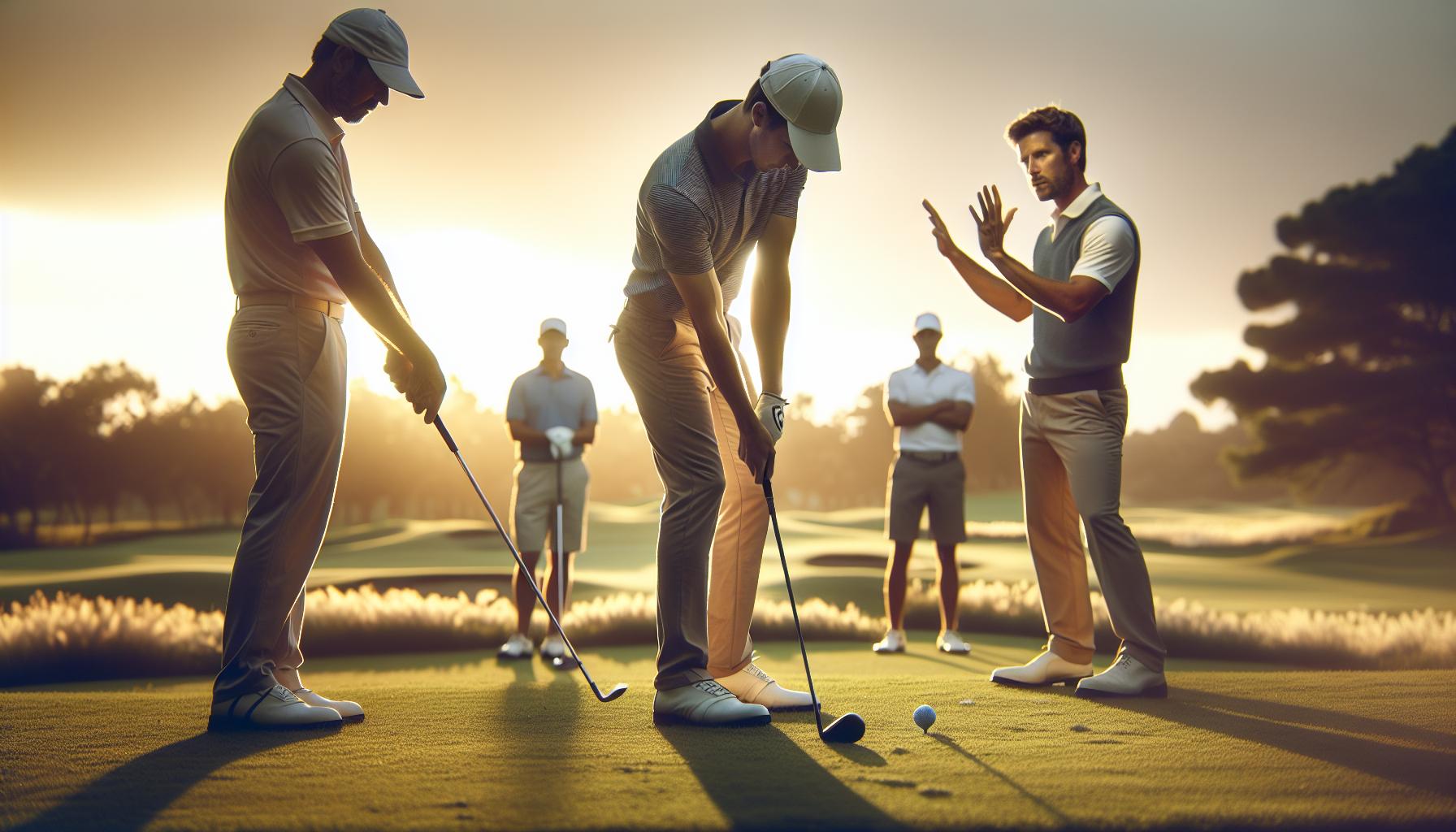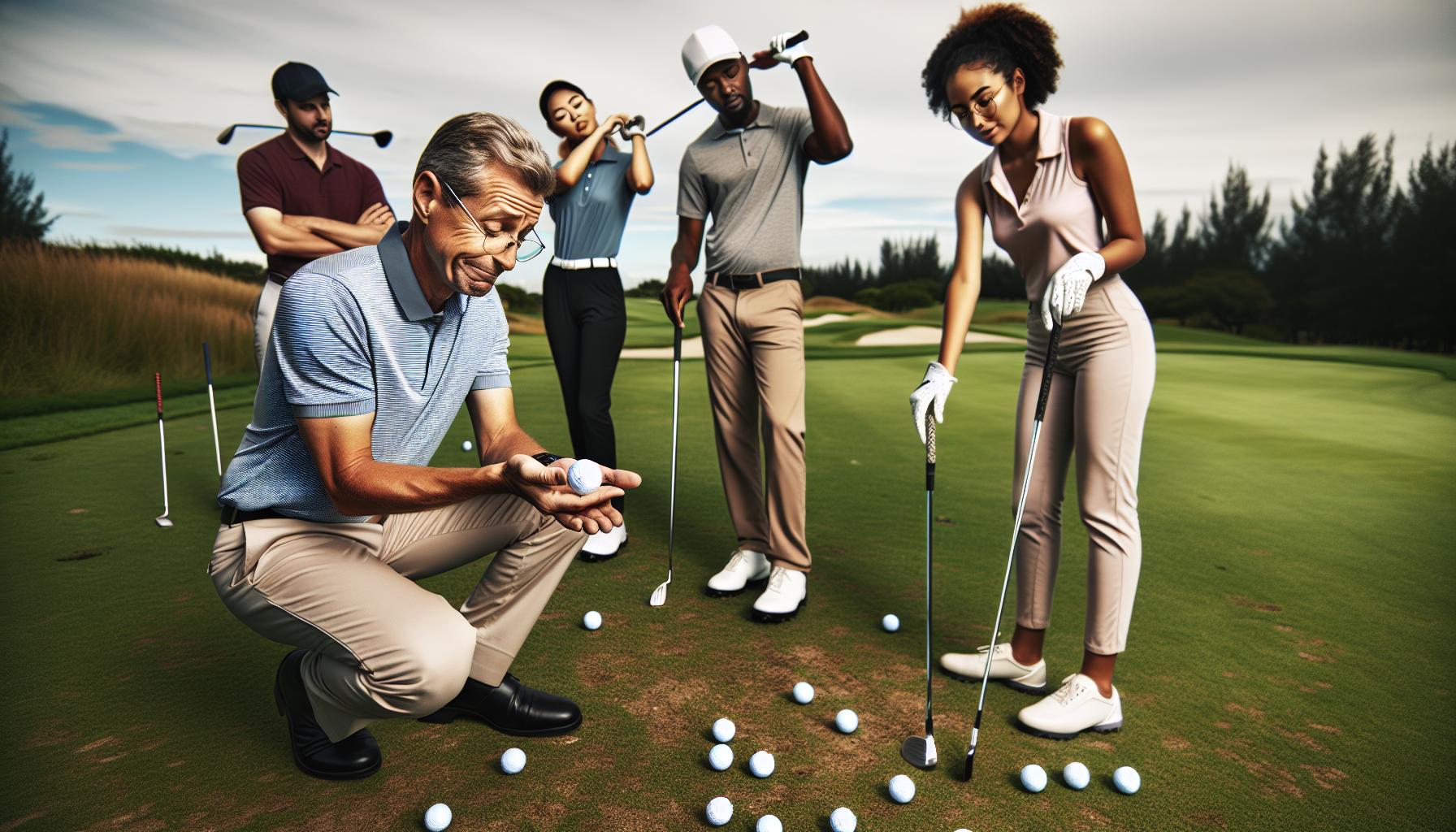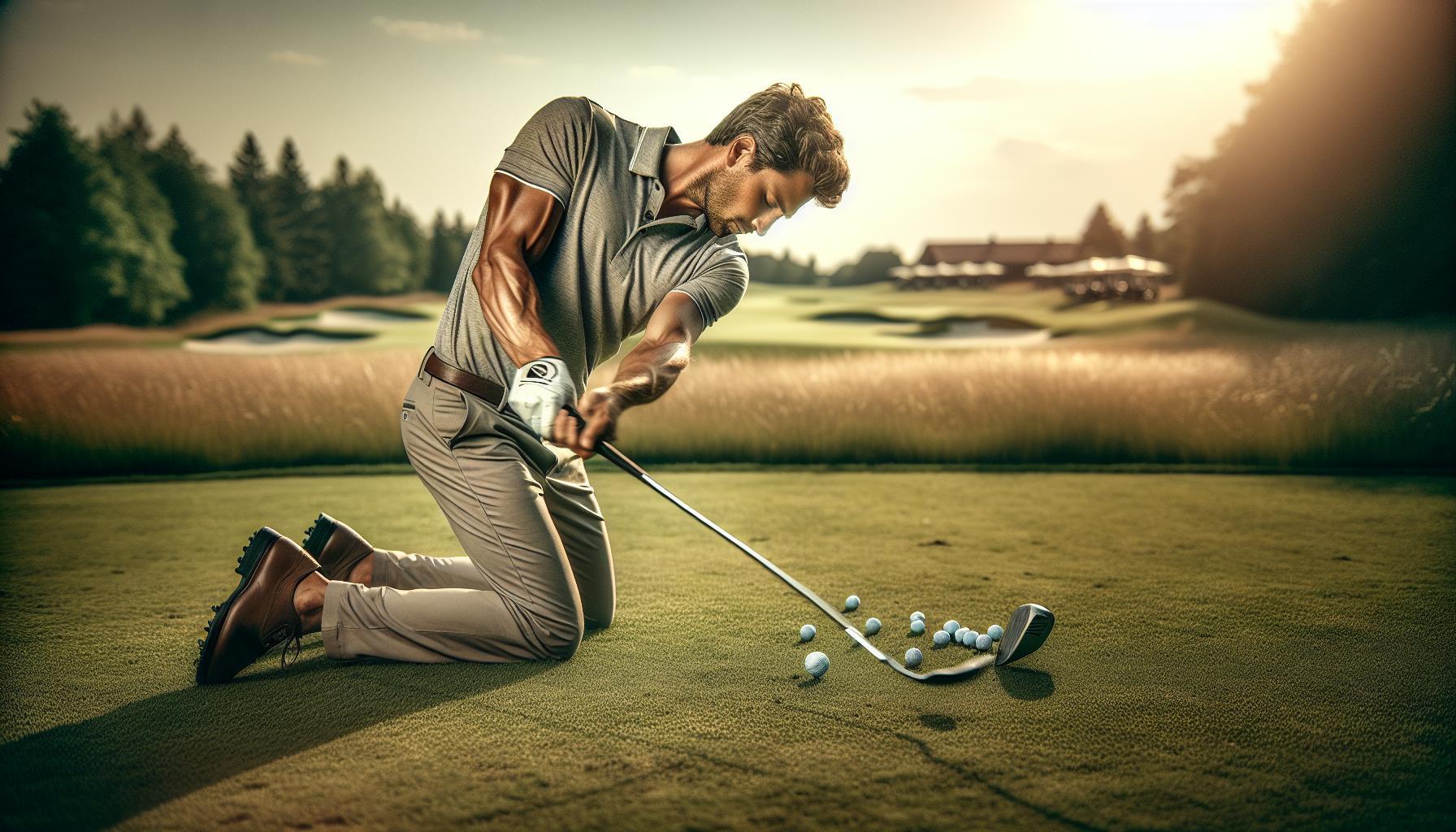Topping the golf ball is a common frustration for players of all skill levels, often leading to embarrassment and missed opportunities on the course. Did you know that even the most seasoned golfers grapple with this issue? Understanding how to consistently strike the ball cleanly can drastically improve your game and boost your confidence.
In this guide, we’ll delve into practical techniques and strategies to help you eliminate topping the ball for good. Whether you’re struggling with club positioning or swing mechanics, our insights are tailored to address your specific challenges. Get ready to transform your approach and elevate your performance on the green as we uncover the keys to achieving a more precise, powerful swing.
Understanding Why You Top the Golf Ball

Topping the golf ball is a frustrating challenge that many players face, often stemming from a misunderstanding of the fundamental mechanics of the swing. At its core, topping occurs when the clubface makes contact with the upper half of the ball, primarily due to improper swing tempo, ball position, or body alignment. A common error is the instinctive urge to lift the ball into the air, which leads to an upward strike instead of a downward one. This incorrect intention prevents the club from making the necessary downward angle of attack, crucial for solid contact and effective ball flight.
One major factor contributing to this issue is the player’s stance and setup. If a golfer’s weight shifts excessively to the back foot during the swing, this can lead to an overly steep angle of attack, causing the club to strike the ball at the wrong moment. Additionally, maintaining a stable lower body is essential to achieving proper swing mechanics. It is also noteworthy that the correct timing and rhythm in your swing are vital-rushing the swing can further exacerbate the tendency to top the ball. Ensuring a smooth, controlled swing will help foster better contact with the ball.
Course conditions and club selection can also play a role in topping the ball. For instance, hitting from uneven lies may disrupt the swing path, and using the wrong club for a specific shot can lead to inconsistent swing mechanics. Understanding how different surfaces and clubs affect your ball flight is essential for improving performance on the course. By acknowledging these factors and making necessary adjustments, golfers can significantly reduce the instance of topping the ball and improve overall swing efficiency.
Key Techniques to Correct Your Swing Mechanic
The foundation of a consistent golf swing lies in mastering key techniques that address and correct the mechanics that lead to topping the ball. Understanding that a proper swing is rooted in a stable and balanced setup can make all the difference in performance. One primary technique is to ensure your weight is evenly distributed between both feet at address; this balance promotes stability, which is crucial during the swing motion. A misaligned stance often contributes to poor swing mechanics, so place your feet shoulder-width apart and align your body parallel to your target line.
Another critical element is the angle of your wrists during the swing. Many golfers set up with a cupped wrist at the top of their backswing, leading to an improper angle of attack. Focus on keeping your lead wrist flat and your trail wrist slightly bowed. This positioning helps ensure that your clubface contacts the ball squarely, promoting a downward strike necessary to achieve solid ball contact. Practicing slow, deliberate swings can reinforce the correct wrist position, leading to improved consistency and reduced topping.
Furthermore, swing tempo plays a vital role in achieving consistency. Many players swing too aggressively, attempting to generate power, only to find themselves topping the ball as a result. Focus on a rhythmical swing, starting slowly and gradually increasing your speed as you become more comfortable with your mechanics. Consider using a metronome or rhythm band to train your swing tempo. This method allows you to practice maintaining a smooth swing while developing the necessary muscle memory.
Finally, it is essential to visualize the swing path. Many golfers fail to commit to a low and sweeping motion through the ball. As you prepare to swing, visualize your club sweeping through the ball low to the ground. This mental imagery can help instill the correct intention, significantly reducing the chances of topping the ball. Continuously reflecting on these key swing techniques will empower you to transform your game and achieve a better, more stable strike.
The Impact of Equipment on Topping the Ball

Topping the golf ball can often be traced back to more than just swing mechanics; the choice of equipment plays a pivotal role in your success on the course. Golf balls come in various designs, each suited to different swing speeds and player preferences. When considering how equipment impacts topping, it’s essential to analyze not only the golf ball but also your clubs. The right combination can significantly enhance your ability to connect solidly with the golf ball, minimizing those frustrating tops.
When selecting a golf ball, look at its compression rating and cover materials. High-compression balls (like the Titleist Pro V1) are designed for faster swing speeds and offer a more controlled, penetrating ball flight. In contrast, lower compression models (such as the Callaway Supersoft) can help slower swing speed players achieve greater distance and a softer feel. Choosing a ball that complements your swing speed can lead to improved performance and reduced topping, as you’ll find it easier to achieve the necessary lift and trajectory.
Beyond the golf ball, club fit must also be addressed. The length and angle of the club’s shaft can influence your swing plane and impact dynamics. A club that’s too long can make it difficult to maintain proper posture and balance, leading to inconsistencies in contact with the ball. For instance, if you find yourself consistently topping your shots, consider a club with a shorter shaft or using a more suitable lie angle to ensure you can strike the ball effectively without losing control.
Moreover, pay attention to the clubface technology designed to improve forgiveness and minimize error. Clubs designed with a lower center of gravity (like the TaylorMade M4 drivers) can help elevate the ball more easily, combating the tendency to top. This technology can be extremely beneficial, as it allows for a more optimal launch angle and improved overall ball performance.
Incorporating the correct equipment is not merely about personal preference; it is vital to evaluate how each piece affects your swing dynamics. A well-fitted set of clubs and a carefully selected ball tailor-made for your game can mitigate the frustrations of topping the ball and lead to a more enjoyable golfing experience.
Common Misconceptions About Topping Golf Balls

Misunderstandings abound when it comes to the reasons behind topping a golf ball, leading many to focus only on swing mechanics without considering other factors. One common misconception is that topping primarily stems from an incorrect swing path. While swing path is certainly a contributor, many golfers overlook the critical roles of posture, weight transfer, and setup. For example, standing too far from the ball can lead to a disconnected swing, causing golfers to strike the top part of the ball inadvertently. Conversely, being too close restricts proper shoulder and arm movement, which can also result in topping.
Another frequent fallacy is the belief that the problem lies solely in the golfer’s technique, ignoring the influence of equipment. The choice of golf ball and club can dramatically affect performance, and mismatched equipment can exacerbate issues with topping. A low-compression golf ball, such as the Callaway Supersoft, is tailored for slower swing speeds and can often alleviate topping by providing a better launch angle. On the other hand, a high-compression ball, like the Titleist Pro V1, requires a more consistent, faster swing to achieve optimal results. Not accounting for one’s swing characteristics when selecting a ball or club can perpetuate the topping problem.
Additionally, many players believe that all golfing equipment should remain uniform across different shots, but this is misleading. For example, using a shorter club on approach shots can help in maintaining better posture and control over the ball, reducing the likelihood of topping. Moreover, golfers tend to underestimate the importance of regular practice focused on their unique vulnerabilities. Relying on generic advice can lead to frustration and stagnation; tailored practice routines that focus on specific issues, such as topping, can yield significant improvements.
Lastly, mental factors cannot be overlooked. Many golfers approach their game with a perfectionist attitude, which can amplify pressures and lead to overthinking. This heightened anxiety can cause tension in the arms and hands, resulting in premature strikes on the ball’s upper half. Recognizing this connection between mindset and physical performance is essential in overcoming the challenges associated with topping the ball. By combining an awareness of these common misconceptions with targeted practice and the right equipment, golfers can significantly reduce the incidence of topping and improve their overall game.
How to Improve Your Setup and Stance

Improving your setup and stance can significantly reduce topping the golf ball and enhance your overall performance. A well-aligned posture not only positions you optimally for a good strike but also creates a strong foundation for your swing mechanics. Many golfers underestimate critical aspects of their setup such as distance from the ball, balance, and grip pressure, which can all lead to mishits like topping.
Begin by standing with your feet shoulder-width apart, ensuring a stable base. This stance allows for proper weight distribution and balance throughout your swing. Your knees should be slightly flexed to provide a lower center of gravity, which aids in maintaining balance during the swing. In terms of distance from the ball, a good rule of thumb is to extend your arms naturally, allowing the club to rest on the ground without forcing it. Standing too far away can disrupt your swing arc, while being too close can cause you to lift the club too early in the backswing, potentially leading to topping issues.
Next, consider your posture. Bend slightly from your hips, keeping your back straight and your shoulders relaxed. This position helps maintain a good spine angle, which is crucial for achieving an effective swing. Check that your clubface is aligned with your target line and that your grip is neither too tight nor too loose. Excessive tension in your grip can lead to swing inconsistencies, including topping the ball. Focus on a light, relaxed grip that allows for natural wrist movement.
Lastly, ensure that your head remains still and your eyes are focused on the ball throughout the entire swing. This concentration helps with timing and can prevent premature upward movement prior to contact, which is a common cause of topping. Regularly practicing your setup in front of a mirror or during warm-up sessions can help reinforce these habits. By refining your stance and setup, you’ll create the conditions necessary for a powerful, consistent swing that minimizes the risk of topping the golf ball.
Drills to Prevent Topping the Golf Ball
Practicing specific drills can be incredibly effective in preventing the frustrating issue of topping the golf ball. The key is to focus on both mechanics and feel, ensuring that each swing is intentional and controlled.
One excellent drill is the Half-Swing Drill. Start by making half swings with your irons, focusing exclusively on making solid contact with the ball on the ground. Position an alignment stick a few inches in front of your ball and practice hitting the ball without touching the stick. This drill promotes a downward strike, emphasizing the correct angle of attack, helping to instill the proper feeling of striking the ball cleanly without topping it.
Another effective technique is the Ball Position Drill. Place a ball on a tees or a slight mound of turf, ensuring that it is slightly above the level of the grass. This elevation encourages a downward strike and prevents the common tendency to lift the clubhead too early. As you practice, pay attention to your balance and weight distribution throughout the swing. Maintaining a steady head position will help you keep your eye on the ball until impact, reducing the likelihood of topping.
Incorporating Footwork Drills can also significantly improve stability during your swing. Use a mirror or video recording to analyze your stance and movement. Set up in your proper stance and focus on maintaining weight evenly distributed on the balls of your feet. Practice swinging while concentrating on keeping your feet planted, which will promote proper rotation of your hips and shoulders without swaying or lifting.
Lastly, consider the Slow Motion Swing Drill, where you perform your swing at a very slow pace. This allows you to feel the proper mechanics and timing without the instinct to rush through the motion. As you develop a better understanding of your body’s movements, it enhances muscle memory, reducing the chance of topping the ball when you return to a regular pace.
By consistently practicing these drills, you’ll develop a more reliable swing that minimizes the risk of topping the golf ball, ultimately enhancing your overall game performance.
Visual and Mental Strategies for Better Shots
The mind plays an integral role in golf performance, particularly when it comes to making consistent and solid contact with the ball. Topping, a common frustration among golfers, can often be exacerbated by mental distractions or performance anxiety. By implementing effective visual and mental strategies, players can enhance focus and confidence, vital elements in achieving a smooth swing and cleaner strikes.
Visualization is a powerful tool that allows golfers to mentally rehearse their swings and the desired ball flight. Before stepping up to the tee, take a moment to visualize a successful shot. Picture the entire process: from your address position, the feel of a smooth takeaway, to the ball soaring beautifully down the fairway. This mental rehearsal can significantly improve focus and reduce tension during the actual swing, fostering the confidence needed to execute the shot as intended.
Incorporating mindfulness techniques during practice also aids in combatting the urge to rush or over-swing. By concentrating on your breathing and maintaining awareness of the present moment, you become more in tune with your body and less influenced by outside pressures. One practical method is to take a deep breath just before addressing the ball, allowing the exhalation to settle your nerves and center your focus. This practice not only helps in calming the mind but also supports a more fluid motion.
Another effective mental strategy is to create a pre-shot routine that includes positive affirmations. For instance, repeating phrases such as “I strike the ball with confidence” or “I maintain balance and poise” can lead to an improved mindset. These affirmations reinforce your commitment to executing the shot properly, steering your thoughts away from the fear of topping the ball.
Focus Techniques to Enhance Performance
Consider the following techniques to further solidify your mental game:
- Set Specific Goals: Instead of broad objectives like “hit the ball well,” aim for measurable goals like “contact the ball with the bottom half of the clubface.”
- Routine Repetition: Develop a consistent practice routine that reinforces mechanics, as muscle memory thrives in familiar patterns.
- Positive Visualization: Spend time visualizing ideal shots, including the sound, feel, and trajectory of successful strikes.
By integrating these visual and mental strategies into your game, you are not only addressing the technical aspects of your swing but also nurturing the psychological elements necessary for consistent performance. As your mental approach improves, you will likely find that not only does topping the ball become a thing of the past, but your overall game also enhances, leading to greater enjoyment and lower scores on the course.
How Strength and Flexibility Influence Your Swing
Understanding the influence of strength and flexibility on your swing can be a game-changer in preventing topped shots. Golf is a dynamic sport that requires not only refined technique but also adequate physical conditioning. Strength, particularly in the core, legs, and upper body, provides the necessary stability and power for a consistent swing. For instance, strong core muscles support your rotational movements and balance during the swing, which helps maintain posture and prevents unnecessary rising or swaying that often leads to topping the ball.
Flexibility plays an equally critical role, allowing for a fuller range of motion. When you possess good flexibility in your shoulders, hips, and lower back, you can achieve a more effective backswing and downswing. This adaptability leads not only to better swing mechanics but also ensures that your body can withstand the physical demands of a golf swing without compromising form. A flexible golfer can more easily maintain proper angles throughout the swing, which is essential for achieving solid contact.
Incorporating strength training and flexibility exercises into your routine can dramatically enhance your performance. Here are some practical recommendations:
- Strength Training: Focus on exercises that target the core (e.g., planks, Russian twists), legs (e.g., squats, lunges), and upper body (e.g., push-ups, resistance band exercises). These will build the necessary muscle groups for a powerful swing.
- Flexibility Exercises: Implement stretches and mobility drills such as dynamic lunges, shoulder dislocations, and torso twists. Yoga can also be a beneficial practice to improve flexibility and balance.
Aside from specific exercises, consider integrating a warm-up routine that includes dynamic stretching before you hit the course. This preparation not only enhances flexibility but also primes your muscles for the range of motions you’ll employ during your swing. By investing time in building strength and flexibility, you can significantly reduce the risk of topping the ball and improve your overall enjoyment of the game.
Analyzing Your Golf Swing: Tools and Methods
Analyzing your golf swing is a pivotal step in overcoming the dreaded topped shot. With the right tools and methods, golfers can gain invaluable insights into their swing mechanics and a clearer understanding of how to make necessary adjustments. From advanced technology to simple self-assessments, there are plenty of resources available to analyze your swing effectively.
One of the most effective methods is using swing analysis software or applications, such as TrackMan or Swing Catalyst. These tools utilize high-speed cameras and Doppler radar technology to provide detailed metrics on your swing, including club speed, angle of attack, and ball flight. By reviewing this data, you can pinpoint specific areas of your swing that may be causing topped shots. For example, if your analysis indicates that your angle of attack is consistently too steep, you can adjust your setup and swing plane accordingly.
Additionally, consider using video analysis to capture your swing from various angles. Many smartphones come equipped with sufficient video capabilities, allowing you to record your swing and analyze it later. Look for common errors, such as an improper follow-through or incorrect wrist position. Using video playback, you can slow down your swing to observe these minor details that are often overlooked during real-time performance. This reflection helps to create a tangible connection between your visual and physical understanding of the swing.
Feel free to combine these methods with qualitative feedback gathered from on-course performance. Pay attention to where you often experience topped shots in your game – is it primarily with certain clubs, or on particular lies? Understanding the environmental factors and how they affect your swing can further refine your practice routine.
Finally, keep a swing diary where you document your practices, insights, and progress over time. Regularly logging your experiences allows you to observe patterns, track your improvement, and keep you motivated. By leveraging both technology and personal observation, you can systematically tackle swing faults and significantly lower your chances of topping the golf ball.
Real-Life Success Stories: Overcoming Frustration
Overcoming the frustration of topping the golf ball is an attainable goal, and numerous golfers have shared their success stories. Take the case of Mark, a 15-handicap golfer who struggled with topped shots, particularly off the tee. After watching countless instructional videos and seeking advice from friends, he took a structured approach to his problem. By integrating swing analysis technology, such as high-speed video recording, he was able to identify specific mechanical flaws in his swing, including an inconsistent follow-through and an early release of the club.
In another inspiring example, Sarah, a beginner golfer, faced the challenge of consistently topping her shots. Discouraged after her first few rounds, she decided to focus on her setup and stance. By adopting a more grounded stance and learning the proper ball placement, she drastically improved her ball striking. She utilized drills such as the “foot spray method,” which helped her visualize where the club was making contact on the ball and adjusted her swing mechanics accordingly. This transformation not only saved her scores but also rekindled her love for the game.
Real-life transformations like these often highlight the importance of perseverance and the willingness to adapt one’s technique. Utilizing proper equipment can further enhance results. For instance, using golf balls designed for optimized launch conditions, like the Titleist Pro V1 or the Callaway Chrome Soft, can complement improved swing mechanics by offering better feedback on contact. These balls feature advanced construction technology that maximizes performance, making it easier to see the results of a well-executed swing.
Many golfers also turn to community forums and clubs, sharing tips and small victories which reinforce the notion that topping the golf ball is not an insurmountable issue. Engaging with fellow golfers allows for the exchange of effective strategies and creates a supportive environment that encourages ongoing improvement. With a commitment to practice, the right mindset, and community support, overcoming the frustration of topping the ball becomes a realistic achievement for golfers at any level.
Maintaining Consistency: Practice Tips and Routines
Building a consistent practice routine is essential for every golfer looking to eliminate topped shots and enhance their overall game. One pivotal aspect of this journey is establishing a disciplined training regimen that encompasses various components of your swing, stance, and equipment. By dedicating time to practice these specific areas, you will not only improve your swing mechanics but also build the confidence needed to face every round with assurance.
To maintain consistency, consider implementing the following effective practice tips:
Structured Practice Sessions
- Warm-Up Routines: Always begin with a warm-up to loosen your muscles and prepare your body for the motions required in golf. Simple stretching exercises focusing on your shoulders, arms, and hips can be beneficial. Incorporate dynamic stretches, like torso twists and swinging motions, to enhance flexibility and readiness.
- Focused drills: Dedicate at least one practice session per week solely to addressing topping issues. Utilize drills that emphasize proper clubhead position and follow-through. A great drill is the “teed-up ball drill,” where you place a tee just above ground level and focus on striking the ball without removing the tee.
- Short Game Focus: Here, consistency is key. Spend time on the putting green to refine your touch and confidence around the greens. Practice different lies and slopes, as these can often lead to varied results.
Tracking Progress
Utilizing technology can also play a crucial role in maintaining consistency. Devices like swing analyzers and apps that track your progress provide immediate feedback on your swing mechanics. For instance, the Arccos Caddie system utilizes sensors that give you vital data on club distances and helps analyze your game. Keeping a journal of your practice sessions is also a simple yet effective way to identify patterns and areas for improvement.
Engaging with Community
Lastly, never underestimate the power of community engagement. Joining local golf clubs or online forums offers you the opportunity to share experiences and strategies with fellow golfers. Participating in group practice sessions can motivate you and introduce you to new drills and techniques that you might not have considered.
By integrating these practical tips and maintaining a focused routine, you can ensure steady improvement and ultimately stop topping the ball for good. With practice grounded in consistency and community support, you’ll find your confidence and performance on the course soaring to new heights.
Resources for Ongoing Improvement and Support
To effectively combat topped shots in golf, golfers need access to a range of resources that can provide ongoing support and improvement. Understanding the right equipment and utilizing the latest technology can significantly enhance a player’s performance. For instance, modern golf balls have varying compression ratings and constructions, which influence how they interact with the clubface and the ground. Choosing a ball that matches your swing speed and skill level can help achieve optimal launch conditions, reducing the tendency to top the ball. Brands like Titleist, Callaway, and TaylorMade offer detailed specifications about their products, allowing players to make informed decisions based on their unique playing style.
Utilizing Technology
Embrace swing analysis software to get detailed insights into your swing mechanics. Tools such as TrackMan or FlightScope provide valuable data that helps identify swing flaws contributing to topped shots. Monitoring aspects like clubhead speed, angle of attack, and swing path will enable you to pinpoint exact areas for improvement. Additionally, mobile apps that track your performance can help establish trends over time, giving you a clearer picture of your progress.
Educational Resources
Consider investing in instructional materials, such as books or online golf courses focused on improving swing mechanics. Authors like David Leadbetter and Michael Breed have published numerous resources that address common issues, including topping the ball. YouTube channels dedicated to golf instruction often provide visual guides to common mistakes and corrective techniques, making it easier to grasp critical concepts and visualize the proper swing mechanics.
Engaging with a Community
Joining online forums or local golf clubs can offer not just camaraderie but also invaluable insights from fellow golfers dealing with the same challenges. Sharing experiences, tips, and drills can foster a supportive environment that motivates improvement. Moreover, participating in group coaching sessions or clinics can provide immediate feedback from experienced instructors, helping you refine your technique in a collaborative atmosphere.
By leveraging these resources, golfers can streamline their learning process and find effective strategies to eradicate topped shots from their game. Whether through the right equipment, cutting-edge technology, expert education, or community engagement, the path to a more consistent and confident golf game is well within reach.
Q&A
Q: What are common causes of topping the golf ball?
A: Topping the golf ball can be caused by several factors, including poor posture, an incorrect swing path, or insufficient weight transfer during your swing. Understanding these causes can help you adjust your technique for better contact with the ball. Refer to the “Understanding Why You Top the Golf Ball” section for detailed insights.
Q: How can my grip affect topping the golf ball?
A: A poor grip can compromise your swing mechanics, leading to topping the ball. Ensure that your grip is neutral, avoiding excessive tension. Experiment with grip adjustments to find a comfortable position that allows you to control the clubface better.
Q: Why is my setup so important for preventing topped shots?
A: Your setup is crucial for ensuring proper contact with the ball. A correct stance and alignment help establish a solid foundation for your swing. Focus on addressing the ball with a balanced position to improve your chances of striking it cleanly.
Q: Are there specific drills to help fix topping the ball?
A: Yes, specific drills such as the “Quarter Swing Drill” can promote a more controlled motion and help prevent topping. These drills focus on executing shorter, more deliberate swings to reinforce proper mechanics. Check the “Drills to Prevent Topping the Golf Ball” section for more.
Q: How does ball position affect topping the ball?
A: Ball position influences your swing path and angle at impact. Placing the ball too far forward in your stance may lead to topping. Aim to position the ball in line with the inside of your front foot for a more stable swing.
Q: Can adjusting my swing speed help stop topping the ball?
A: Yes, swinging at a controlled speed allows for better timing and balance, which can prevent topping. Focus on making smooth, rhythmic swings rather than trying to hit the ball too hard.
Q: What mental strategies can I use to stop topping the golf ball?
A: Mental strategies such as visualization and focusing on smooth execution can help improve your performance. Approach each shot with a calm mindset, reminding yourself to trust your mechanics and stay relaxed throughout your swing.
Q: When should I seek professional help for topping issues?
A: If you consistently top the ball despite applying various techniques and drills, it might be time to seek professional coaching. A golf instructor can provide personalized feedback and tailored strategies to eliminate the issue effectively.
For more insights and techniques, be sure to explore other sections like “Key Techniques to Correct Your Swing Mechanic” and “Visual and Mental Strategies for Better Shots” in the article.
In Retrospect
Now that you’ve learned how to stop topping the golf ball for good, it’s time to put those techniques into action and transform your game! Remember, mastering your swing and solid ball contact is crucial for consistent performance on the course. If you want to delve deeper, check out our articles on “Essential Drills for Improving Your Golf Swing” and “Choosing the Right Golf Balls for Your Style.”
Don’t forget to sign up for our newsletter for more insights, tips, and exclusive offers that will help elevate your golf skills. Share your experiences with our community in the comments below-your feedback helps us create better content. Stay motivated, and keep practicing; the results will come. Let’s make this your best season yet!

